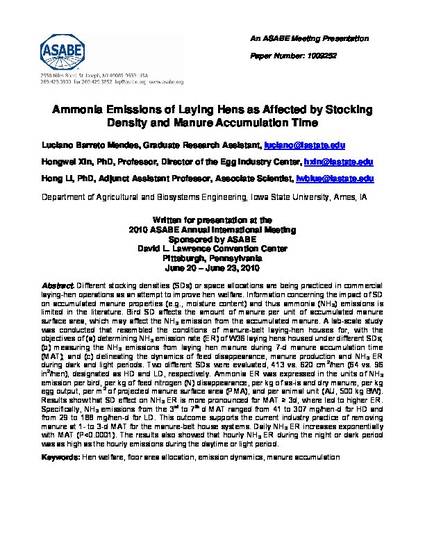
Article
Ammonia Emissions of Laying Hens as Affected by Stocking Density and Manure Accumulation Time
Agricultural and Biosystems Engineering Conference Proceedings and Presentations
Document Type
Conference Proceeding
Disciplines
Conference
2010 ASABE Annual International Meeting
Publication Date
6-1-2010
Geolocation
(40.4406248, -79.9958864)
Abstract
Different stocking densities (SDs) or space allocations are being practiced in commercial laying-hen operations as an attempt to improve hen welfare. Information concerning the impact of SD on accumulated manure properties (e.g., moisture content) and thus ammonia (NH3) emissions is limited in the literature. Bird SD affects the amount of manure per unit of accumulated manure surface area, which may affect the NH3 emission from the accumulated manure. A lab-scale study was conducted that resembled the conditions of manure-belt laying-hen houses for, with the objectives of (a) determining NH3 emission rate (ER) of W36 laying hens housed under different SDs; (b) measuring the NH3 emissions from laying hen manure during 7-d manure accumulation time (MAT); and (c) delineating the dynamics of feed disappearance, manure production and NH3 ER during dark and light periods. Two different SDs were evaluated, 413 vs. 620 cm2/hen (64 vs. 96 in2/hen), designated as HD and LD, respectively. Ammonia ER was expressed in the units of NH3 emission per bird, per kg of feed nitrogen (N) disappearance, per kg of as-is and dry manure, per kg egg output, per m2 of projected manure surface area (PMA), and per animal unit (AU, 500 kg BW). Results show that SD effect on NH3 ER is more pronounced for MAT = 3d, where led to higher ER. Specifically, NH3 emissions from the 3rd to 7th d MAT ranged from 41 to 307 mg/hen-d for HD and from 29 to 188 mg/hen-d for LD. This outcome supports the current industry practice of removing manure at 1- to 3-d MAT for the manure-belt house systems. Daily NH3 ER increases exponentially with MAT (P<0.0001). The results also showed that hourly NH3 ER during the night or dark period was as high as the hourly emissions during the daytime or light period.
Copyright Owner
American Society of Agricultural and Biological Engineers
Copyright Date
2010
Language
en
Citation Information
Luciano B. Mendes, Hongwei Xin and Hong Li. "Ammonia Emissions of Laying Hens as Affected by Stocking Density and Manure Accumulation Time" Pittsburgh, PA(2010) Available at: http://works.bepress.com/hongwei_xin/136/

This is an ASABE Meeting Presentation, Paper No. 1009252.